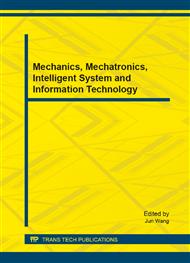[1]
Ma Yunfei, He Wenzhang. Foggy day image enhancementI method based on wavelet transform [J]. Computer Application and Software. 2011, 28(2): 71-73.
Google Scholar
[2]
Rafacel C Gonzalez. Digital Image processing (The Second Edition) (M) . Publishing House of Electronics Industry. 2007, 59-174.
Google Scholar
[3]
H.D. Cheng, Rui Min, Ming Zhang. Automatic wavelet base selection and its application to contrast enhancement[J]. Signal Processing 90 (2010) 1279–1289.
DOI: 10.1016/j.sigpro.2009.10.013
Google Scholar
[4]
Bin-bin Hao, Min Li, Xiang-chu Feng. Wavelet iterative regularization for image restoration with varying scale parameter[J]. Signal Processing: Image Communication 23 (2008) 433–441.
DOI: 10.1016/j.image.2008.04.006
Google Scholar
[5]
V. Bruni, D. Vitulano. Combined image compression and denoising using wavelets[J]. Signal Processing: Image Communication 22 (2007) 86–101.
DOI: 10.1016/j.image.2006.11.006
Google Scholar
[6]
NI Xue, LI Qing-wu, CHEN Xiao-gang. Low contrast image enhancement based on second generation curvelet transform[J]. Computer Engineering and Applications. 2008, 44(17): 188-190.
Google Scholar
[7]
ZHU Wei, LI Guo-hui, TU Dan. Based on 2nd generation curvelet transform denoising methods related to the scale[J]. Journal of Image and Graphics. 2008, 13(12): 2281-2285.
Google Scholar
[8]
BAI Hao, WANG Xiao-qing, CHEN Yong-qiang. A new curvelet-based method for SAR image feature enhancement[J]. Journal of the Graduate School of the Chinese Academy of Sciences. 2011, 28(2): 228-234.
Google Scholar
[9]
Candes EJ, Demanet L, Donoho DL et a1. Fast discrete curvelet transforms[J]. Multiscale Modeling and Simulation. 2006, 5(3): 861-899.
DOI: 10.1137/05064182x
Google Scholar
[10]
G.G. Bhutada, R.S. Anand, S.C. Saxena. Edge preserved image enhancement using adaptive fusion of images denoised by wavelet and curvelet transform, Digital Signal Processing 21 (2011) 118–130.
DOI: 10.1016/j.dsp.2010.09.002
Google Scholar
[11]
Cand'es EJ, Demanet L, Donoho DL, et a1. Fast discrete curvelet Transforms[R]. USA Caltech: Applied and Computational Mathematics, California Institute of Technology, (2005).
Google Scholar
[12]
Aliaa.A. Youssif, A.A. Darwish, A.M.M. Madbouly. Adaptive Algorithm for Image Denoising Based on Curvelet Threshold[J]. International Journal of Computer Science and Network Security, 2010, 10(1): 322-328.
Google Scholar
[13]
LIAO Shi-peng, LIAO Jun-bi, LI Bin-bin. Application of Fast Curvelet Transform in the Image's Edge Enhancement of Machine Vision System[J]. Journal of Sichuan university (Engineering Science edition). 2008, 40(3): 168-172.
Google Scholar
[14]
LIU Cheng-yun, CHEN Zhen-Xue, MA Yu-tao. Adaptive threshold wavelet image denoising[J]. Optical Engineering. 2007, 34(6): 77-80.
Google Scholar


